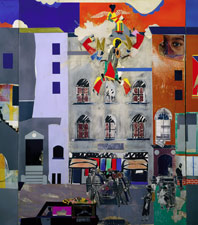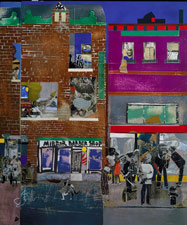New Connections appear every Wednesday. Sign up for a reminder.
Departmental administrator Ryan Wong talks about the ties he perceives between city life and artistic practice.
 1280852
1280852 1280997
1280997 1280839
1280839 6791024
6791024 1280996
1280996 6951024
6951024 1280867
1280867 8481024
8481024 8411024
8411024 1280965
1280965 1280946
1280946 10241024
10241024 1280943
1280943 12801024
12801024 7661024
7661024 1280868
1280868 984677
984677 8281024
8281024 1280285
1280285 9031024
9031024 8071024
8071024 8761024
8761024 8521024
8521024 1280909
1280909 9141024
9141024 12061024
12061024 1280779
1280779 1280790
1280790 1280852
1280852
My name is Ryan Wong, I work in the exhibitions office at the Metropolitan Museum, and I'm going to be talking about the city. I was
born and raised in Los Angeles, and I lived there until the end of high school, so that's my home, that's what I'll always sort of refer to as "the city" in my head, and now I live in New York.
So very early on, this was in middle school, I had a teacher who told me that if you are ever bored in a city, you are boring.
And what he meant by that was that if you cannot find something to do it means there's something wrong with you, you're just not trying hard enough. And I think I sort of took that to heart.
So I've always lived in a city, I probably will always live in a city, and part of that is because he was right.
When I walk down the street in New York and I see the person with the Mohawk next to the banker in the pinstripe suit, that is something that can only happen in cities. You have such a dramatic division of
tasks in the city, that you meet people who are part-time baristas and part-time freelance writers.
You meet people who just prepare flowers for a living. You meet people who just do eyebrows for a living.
You meet people who just take care of dogs for a living. You can also be an artist, because it is a very particular and strange skill.
And I think artists realize this and they pay tribute to the city in their art.
Rome plays this sort of amazing backdrop to the drama of this scene. You know, everyone knows Rome through images in movies and paintings, and for me it's sort of reality-effect, that it's the same city, and what gets washed away is of course all the violence of this scene.
The city outlasts the people that live in it. We still have that physical artifact, even though we don't have any of the human life that took place in front of it.
The city is always a stage for everyone. We're always on when we're in the city. And anyone who's ever taken the subway, they know this experience
of looking at people and seeing them at their most off-guard. You really, I think, learn something about their character. You know how this lady's day was; it was tiring. You can picture sitting across from this guy reading the newspaper; he couldn't care less whether this lady next to him lived or died. He is interested in his own thing.
In New York you are physically, viscerally up against other people, and we just have this amazing ability to pretend that that's not happening, that I'm not touching this stranger. The city builds
that in you, it forces you to be blasé about the overwhelming amount of stimulation that comes at you every minute you live in New York.
In L.A. you're in your car and the most you do is look into the window of the person driving next to you. I remember when I first moved to
New York a couple of years ago, I would just walk for miles because it was such a novel experience to me.
I love The Block because just like when you're walking down a street in New York, you can peer into the lives of the people on the block.
There's everything from this assumption into heaven going on in this church
to people hanging out on the street corner, to
a couple making love in bed, to two children sort of gazing out the window forlornly.
And of course this can all be happening at the same time, mere feet away from each other.
This shows New York as I've always been told it was back then, that is, New York in the seventies was tough, it was gritty, there was more crime, there were more drugs. But at the same time, there's a lot of romance that's attached to that.
I think living in a city is by nature nostalgic. You become attached to the city the same way you become attached to a person. I don't want to gloss over the
dangers and negative sides of a city. You know, cities are home to a lot of poverty, a lot of crime, a lot of inequality, but unlike in the countryside, literally everything
you see in a city was put there by a human being. Everything you can point to in a city is there for a reason, because of
human needs and desires. And you can really read who we are as people by
taking a minute and looking around you in the city.
 |
 |
 |
 |
 |
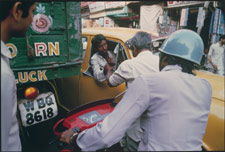 |
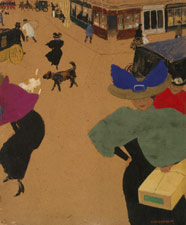 |
 |
 |
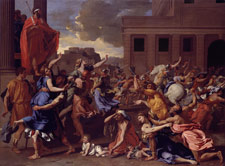 |
 |
 |
 |
 |
 |
 |
 |
 |
 |
 |
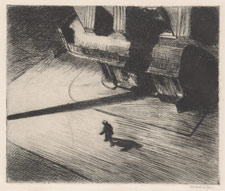 |
 |
 |
Works of art in order of appearanceLast Updated: June 22, 2015. Not all works of art in the Museum's collection may be on view on a particular day. For the most accurate location information, please check this page on the day of your visit. |
||
 |
[Two Prints of Circus Sideshow Billboards, Santa Monica, California] August–September 1947 Walker Evans (American) Dye transfer print Walker Evans Archive, 1994 (1994.261.232.1–2) More information: The Collection Online Not on view
|
 PhotographsSecond Floor
PhotographsSecond Floor |
 |
Station of Otsu: From the Fifty-three Stations of the Tokaido (The "Reisho Tokaido") Edo period, ca. 1848–49 Ando Hiroshige (Japanese) Polychrome woodblock print Frederick Charles Hewitt Bequest Income, 1912 (JP804) More information: The Collection Online Not on view
|
 Asian ArtSecond Floor
Asian ArtSecond Floor |
 |
Parisian Street Scene ca. 1885 Jean Béraud (French) Oil on panel Robert Lehman Collection, 1975 (1975.1.243) More information: The Collection Online Not on view
|
 The Robert Lehman CollectionFirst Floor
The Robert Lehman CollectionFirst Floor |
 |
Apartment Houses, Paris 1946 Jean Dubuffet (French) Oil with sand and charcoal on canvas Bequest of Florene M. Schoenborn, 1995 (1996.403.15) © 2011 Artists Rights Society (ARS), New York / ADAGP, Paris More information: The Collection Online Not on view
|
 Modern and Contemporary ArtSecond Floor
Modern and Contemporary ArtSecond Floor |
 |
Rodeo, New York City 1955 Robert Frank (American, born Switzerland) Gelatin silver print Gift of Barbara and Eugene Schwartz, 1992 (1992.5162.3) More information: The Collection Online Not on view
|
 PhotographsSecond Floor
PhotographsSecond Floor |
 |
Taxi Driver and Pedestrian Argue, Chitpur Road, Calcutta 1987, printed 1991 Raghubir Singh (Indian) Chromogenic print Purchase, Cynthia Hazen Polsky Gift, 1991 (1991.1280) © Raghubir Singh More information: The Collection Online Not on view
|
 PhotographsSecond Floor
PhotographsSecond Floor |
 |
Street Scene in Paris (Coin de rue à Paris) 1895 Félix Vallotton (Swiss) Gouache and oil on cardboard Robert Lehman Collection, 1975 (1975.1.736) More information: The Collection Online Not on view
|
 The Robert Lehman CollectionFirst Floor
The Robert Lehman CollectionFirst Floor |
 |
Avenue des Gobelins 1927 Eugène Atget (French) Albumen silver print from glass negative Ford Motor Company Collection, Gift of Ford Motor Company and John C. Waddell, 1987 (1987.1100.113) More information: The Collection Online Not on view
|
 PhotographsSecond Floor
PhotographsSecond Floor |
 |
Ariadne 1913 Giorgio de Chirico (Italian, born Greece) Oil and graphite on canvas Bequest of Florene M. Schoenborn, 1995 (1996.403.10) © 2011 Artists Rights Society (ARS), New York / SIAE, Rome More information: The Collection Online Not on view
|
 Modern and Contemporary ArtSecond Floor
Modern and Contemporary ArtSecond Floor |
 |
The Abduction of the Sabine Women probably 1633–34 Nicolas Poussin (French) Oil on canvas Harris Brisbane Dick Fund, 1946 (46.160) More information: The Collection Online Not on view
|
 European PaintingsSecond Floor
European PaintingsSecond Floor |
 |
Fresco wall painting in a cubiculum (bedroom) from the Villa of P. Fannius Synistor at Boscoreale ca. 40–30 b.c.; Late Republican Roman Plaster Rogers Fund, 1903 (03.14.13) More information: The Collection Online Not on view
|
 Greek and Roman ArtFirst Floor and Mezzanine
Greek and Roman ArtFirst Floor and Mezzanine |
 |
The Photographer 1942 Jacob Lawrence (American) Watercolor, gouache, and pencil on paper Purchase, Lila Acheson Wallace Gift, 2001 (2001.205) © 2011 The Jacob and Gwendolyn Lawrence Foundation, Seattle / Artists Rights Society (ARS), New York More information: The Collection Online Not on view
|
 Modern and Contemporary ArtSecond Floor
Modern and Contemporary ArtSecond Floor |
 |
[Subway Passengers] 1938 Walker Evans (American) Gelatin silver print Gift of Arnold H. Crane, 1971 (1971.646.18) More information: The Collection Online Not on view
|
 PhotographsSecond Floor
PhotographsSecond Floor |
 |
Berlin Street 1931 George Grosz (American, born Germany) Oil on canvas Hugo Kastor Fund, 1963 (63.220) © Estate of George Grosz/Licensed by VAGA, New York, NY More information: The Collection Online Not on view
|
 Modern and Contemporary ArtSecond Floor
Modern and Contemporary ArtSecond Floor |
 |
[Couple on Fourteenth Street, New York City] 1933–34 Walker Evans (American) Film negative Walker Evans Archive, 1994 (1994.253.102.1) More information: The Collection Online Not on view
|
 PhotographsSecond Floor
PhotographsSecond Floor |
 |
Los Angeles 1964 Garry Winogrand (American) Gelatin silver print Purchase, Nancy and Edwin Marks Gift, 1988 (1988.1137.2) © The Estate of Garry Winogrand, courtesy Fraenkel Gallery, San Francisco More information: The Collection Online Not on view
|
 PhotographsSecond Floor
PhotographsSecond Floor |
 |
Mystery of the Street 1928 Umbo (Otto Umbehr) (German) Gelatin silver print Ford Motor Company Collection, Gift of Ford Motor Company and John C. Waddell, 1987 (1987.1100.49) © Galerie Rudolf Kicken, Cologne and Phyllis Umbehr, Frankfurt/M. More information: The Collection Online Not on view
|
 PhotographsSecond Floor
PhotographsSecond Floor |
 |
The Block 1971 Romare Bearden (American) Cut and pasted printed, colored and metallic papers, photostats, pencil, ink marker, gouache, watercolor, and pen and ink on Masonite Gift of Mr. and Mrs. Samuel Shore, 1978 (1978.61.1–6) © Romare Bearden Foundation/Licensed by VAGA, New York, NY More information: The Collection Online Not on view
|
 Modern and Contemporary ArtSecond Floor
Modern and Contemporary ArtSecond Floor |
 |
Crosby Street 1978 Thomas Struth (German) Gelatin silver print Gift of Henry S. Hacker, 1982 (1982.1053.1) © 2010 Thomas Struth More information: The Collection Online Not on view
|
 PhotographsSecond Floor
PhotographsSecond Floor |
 |
View of Toledo ca. 1597 El Greco (Domenikos Theotokopoulos) (Greek) Oil on canvas H. O. Havemeyer Collection, Bequest of Mrs. H. O. Havemeyer, 1929 (29.100.6) More information: The Collection Online Not on view
|
 European PaintingsSecond Floor
European PaintingsSecond Floor |
 |
Night Shadows 1921 Edward Hopper (American) Etching Harriet Brisbane Dick Fund, 1925 (25.31.2) More information: The Collection Online Not on view
|
 Drawings and PrintsSecond Floor
Drawings and PrintsSecond Floor |
 |
Piazza San Marco late 1720s Canaletto (Italian) Oil on canvas Purchase, Mrs. Charles Wrightsman Gift, 1988 (1988.162) More information: The Collection Online Not on view
|
 European PaintingsSecond Floor
European PaintingsSecond Floor |
 |
The Qianlong Emperor's Southern Inspection Tour, Scroll Six: Entering Suzhou and the Grand Canal Qing dynasty, dated 1770 Xu Yang (Chinese) Handscroll; ink and color on silk Purchase, The Dillon Fund Gift, 1988 (1988.350) More information: The Collection Online Not on view
|
 Second Floor
Second Floor |
© 2011 The Metropolitan Museum of Art |
||

